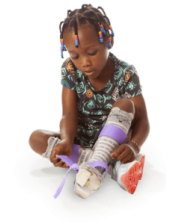What is Erb’s palsy treatment?
Erb’s palsy treatment focuses on restoring arm function and involves methods like physical therapy to improve joint flexibility and muscle strength. While mild nerve damage may heal on its own and without intervention, many cases need various therapies or even surgery.
Erb’s palsy (Erb-Duchenne palsy or brachial plexus palsy) is muscle weakness or paralysis of the arm and shoulder that can happen during childbirth from damage to the brachial plexus nerves.
Most children with Erb’s palsy will recover movement and strength in the affected arm. Starting treatment early significantly improves recovery chances.
Treatment for Erb's palsy may include regular therapy sessions, consistent home exercises, and surgery as a last resort. These treatments require significant time and commitment, often causing new parents to take unexpected time off work.
For many families, compensation from an Erb’s palsy lawsuit allows them to focus on their child's recovery.
Cerebral Palsy Guide works with an extensive network of birth injury law firms that can help families in all 50 states.
Our legal partners have recovered over $1 billion for families like yours.
Get a free case review right now to find out if we may be able to help you seek financial support to help pay for your child’s Erb’s palsy treatment.
How do I know if my child needs Erb’s palsy treatment?
To determine if your child has Erb’s palsy, medical professionals will perform a physical examination and order imaging studies, like an MRI or ultrasound.
They may also run tests to see if any nerve signals exist in the muscle of the upper arm. These tests may include a nerve conduction study (NCS) or an electromyogram (EMG).
Doctors can then determine what type of brachial plexus injury your child has.
- Neuroma happens when a nerve is torn and heals but leaves behind scar tissue. The scar tissue places pressure on the injured nerves and stops them from sending signals to the muscles.
- Avulsion happens when the nerve is torn from the spine. It is the most severe type of Erb’s palsy.
- Rupture occurs when the nerve rips away but not from the spine.
- Neuropraxia happens when nerve fibers are stretched but not torn. It is the most common type of Erb’s palsy.
After identifying the type of injury, your child’s doctor will discuss the most appropriate Erb’s palsy treatment options.
What is the best treatment for brachial plexus injury?
The best treatment for a brachial plexus injury depends on the severity of the child’s condition. For most children, physical therapy is highly effective in improving Erb’s palsy symptoms.
Starting therapy early, ideally around three weeks old, greatly improves recovery chances. Therapy involves exercises to maintain arm flexibility and strength.
In more severe cases, when there is no significant improvement within the first few months, surgery may be necessary. Surgical options include nerve grafts and the transfer of a healthy nerve to the injured area to repair the damaged nerves and restore function.
Other non-surgical treatments focus on keeping the joints flexible and muscles strong. Daily physical therapy and range-of-motion exercises are essential to prevent permanent stiffness and improve muscle function. Parents play a crucial role in performing daily exercises with their child.
Regular follow-ups with health care providers are crucial to monitor progress and adjust treatments as needed.
Proper diagnosis and tailored treatment plans, including the use of diagnostic tools like an MRI, CT, and various nerve tests, are key to successful outcomes in managing brachial plexus injuries.
If you have questions about your child’s Erb’s palsy, our team of labor and delivery nurses is here to help.
Connect with one of our on-staff registered nurses right now.
Erb’s palsy physical therapy
Physical therapy is crucial to treating Erb’s palsy. It focuses on improving joint flexibility and preventing muscle stiffness.
- Passive motion: For infants, parents play a crucial role in therapy by gently moving their child’s arm to ensure the joints remain flexible.
- Range-of-motion exercises: These exercises help keep the joints flexible and prevent them from becoming stiff. They involve gently moving the arm through its full range of motion.
- Gentle stretching: Stretching the muscles helps maintain flexibility and prevent contractures, which are permanent tightenings of the muscles and tendons around the joints.
- Strengthening exercises: As your child grows, strengthening exercises are introduced to build muscle strength in the shoulder and arm. These exercises are essential for regaining full function.
Regular physical therapy sessions, guided by a professional, are essential. However, home exercises are equally important and should be performed consistently.
Parents should follow the specific exercises and routines recommended by their physical therapist to support their child's recovery.
Early and consistent physical therapy can lead to significant improvements in arm function, helping most children with brachial plexus birth palsy regain movement and strength.
Erb’s palsy occupational therapy
Occupational therapy for Erb’s palsy focuses on improving the motor skills necessary for daily activities. Starting therapy early can greatly enhance your child's ability to perform everyday tasks.
These are the 5 stages of occupational therapy for Erb’s palsy:
- Stage 1 (first 2 weeks):
Parents are taught how to properly position and hold their newborn to support the affected shoulder and arm. - Stage 2 (2 weeks to 4 months of age):
Exercises are performed to avoid muscle tightness, improve arm strength, and develop age-appropriate skills, like controlling the head. This includes slow, gentle, and passive range-of-motion (PROM) exercises. - Stage 3 (4 to 6 months):
Therapy focuses on encouraging the child to use both arms simultaneously and developing other age-appropriate skills. - Stage 4 (6 months to 1 year):
Therapists help the child achieve developmental milestones like crawling, sitting, walking, self-feeding, and standing. - Stage 5 (1 to 4 years):
Therapy helps the child learn and maintain fine motor skills, like holding a crayon or spoon. This stage may last longer, depending on the severity of the injury.
Occupational therapy sessions are tailored to meet the specific needs of the child and are often complemented by exercises and activities performed at home.
Surgery to treat Erb's palsy
When physical therapy doesn’t result in significant improvement, surgery may be necessary to treat Erb's palsy. The type of surgery depends on the severity and type of nerve injury.
- Nerve grafts: Healthy nerves from another part of the body are grafted onto the damaged nerve to bridge the gap and help restore function
- Nerve transfers: A less essential functioning nerve is redirected to the area with the damaged nerve to help restore movement and sensation
- Muscle or tendon transfers: Muscles or tendons from another part of the body are moved to replace damaged tissue, improving arm function
- Neurolysis: Scar tissue around the network of nerves is removed to relieve pressure and enhance nerve function
- Surgical decompression: Pressure on the nerves is eased to promote better function
Surgery is typically considered only if there is no significant improvement within the first 3 to 6 months of life.
Recovery from surgery can take several months to years as nerves grow and heal slowly. Rehabilitation exercises post-surgery are essential to your child’s recovery.
Alternative treatment for Erb's palsy
In addition to more traditional Erb’s palsy treatment options, several alternative treatments can help manage the condition and improve arm function. These treatments focus on supporting overall muscle development and relieving symptoms.
Stem cell therapy is showing potential in treating brachial plexus injuries by promoting nerve regeneration and muscle recovery.
These are several alternative Erb’s palsy treatment options:
- Botox therapy: Botulinum toxin injections are used to paralyze stronger muscles temporarily, forcing weaker muscles to work harder and get stronger.
- Hydrotherapy: Water-based exercises that provide resistance and support make movements easier and help improve muscle strength and flexibility.
- Massage therapy: Regular massage can help reduce stiffness, improve circulation, and promote muscle relaxation.
- Recreational therapy: Engaging in play-based activities that encourage the use of the affected arm to improve strength and coordination in a fun and interactive way.
These alternative treatments can complement standard physical therapy and provide additional benefits in managing Erb’s palsy.
Parents should consult with health care providers to determine the best combination of therapies for their child’s specific needs.
How does Erb’s palsy treatment affect prognosis?
Treatment depends on your child’s prognosis (expected health outcome) for Erb’s palsy.
Most children diagnosed with Erb’s palsy will achieve complete recovery and regain full control of their arm through physical therapy.
A small percentage of children may require surgery, and an even smaller fraction will have symptoms that persist throughout their lives.
To increase your baby’s chances of a full recovery, you should start treatment as soon as your child has been diagnosed with Erb’s palsy.
Get help paying for Erb’s palsy treatment
Many families feel overwhelmed and unprepared to pay for the unexpected costs of care that come with brachial plexus injuries during childbirth. Thankfully, there are options to help pay for Erb’s palsy treatment and other expenses.
Sometimes, medical mistakes cause brachial plexus injury. In these cases, financial assistance may be available to ease any burdens placed on your family.
If you suspect your child’s condition could have been avoided, you may have a pathway to accessing the financial support your family needs for the best Erb’s palsy treatment for your child.
Cerebral Palsy Guide partners with top Erb’s palsy lawyers who can help families in all 50 states. Together, they have recovered over $1 billion for families affected by preventable birth injuries, including Erb’s palsy.
Call our experienced patient advocates at (855) 220-1101 right now or get a free case review to find out your options.





